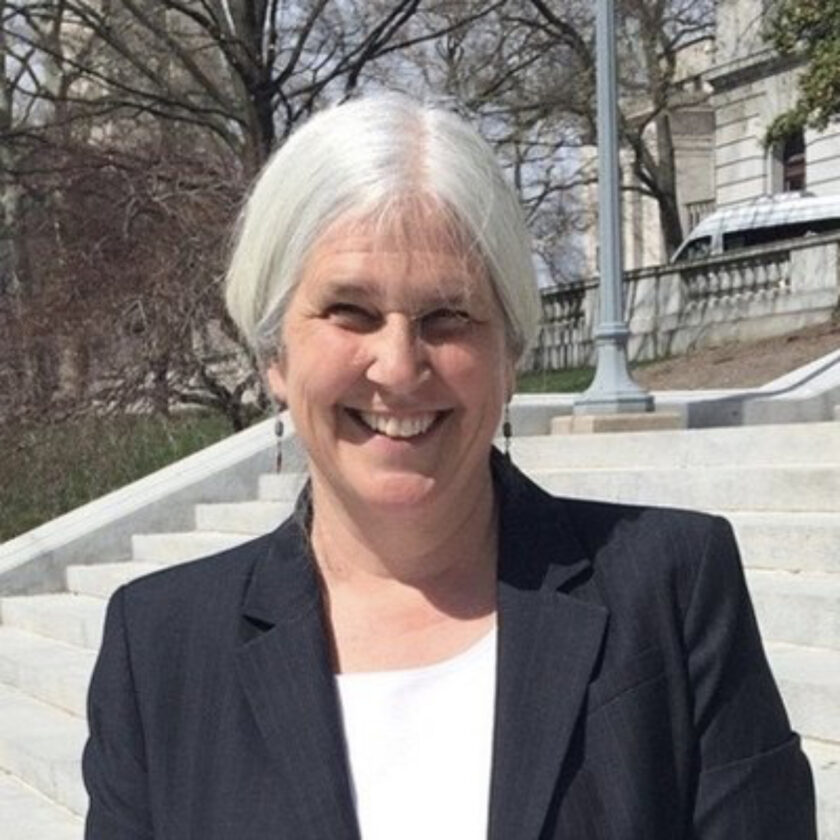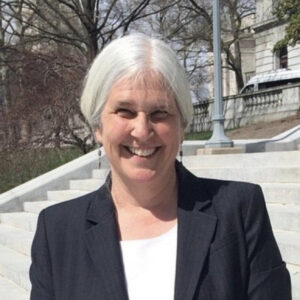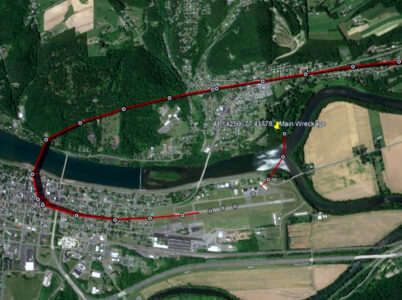Fair Districts PA: Democracy means voters choose their politicians
Advocates say current Pa. law lets politicians choose their voters

PHOTO PROVIDED Carol Kuniholm is pictured.
AVIS — Carol Kuniholm never set out to become one of Pennsylvania’s leading voices against gerrymandering.
A former youth pastor from Chester County, she said she began questioning state government after seeing the stark inequities between her community’s well-funded schools and those in nearby Philadelphia.
“I was struck by how kids in the affluent communities had all the resources they needed and the kids in the less affluent communities didn’t have a school library,” said Kuniholm.
The disparity, she said, made her question how state government worked. Those questions eventually led her to co-found Fair Districts PA, which is the state’s leading voice for redistricting reform.
Kuniholm believes that while Pennsylvanians may differ on policy, most want the same fundamentals: strong families, safe communities, fair pay, clean air and water — and a government that represents everyone.
For nearly a decade, she has pushed for independent redistricting, arguing that gerrymandering — the manipulation of district boundaries to benefit parties or incumbents — undermines democracy itself. Skewed maps, she said, silence voters, shield legislators from accountability and block reforms Pennsylvanians have demanded for decades.
What is gerrymandering?
Every ten years, states use new census data to adjust congressional and state legislative districts to reflect population changes. When done fairly, redistricting creates maps that elect representatives who accurately reflect their communities, but the process also gives those in power a chance to shape districts in ways that tilt the map to their advantage.
“Gerrymandering is drawing district lines to control the outcomes of the election before a single vote is cast,” said Kuniholm. “It is manipulating the lines to keep one party in power or to benefit individual legislators or candidates.”
The practice is nearly as old as American democracy itself. One of the first and most famous cases occured in 1812, when Massachusetts Gov. Elbridge Gerry approved a district so oddly shaped that a political cartoonist compared it to a salamander. That image gave the practice its enduring name.
Over time, lawmakers have developed several tactics to gerrymander districts. One is “cracking,” or splitting a community across multiple districts so its members are diluted into irrelevance. Another is “packing,” which stuffs like-minded voters into as few districts as possible, limiting their influence elsewhere. Redistricting politicians may also engage in “buddymandering” or “sweetheart deals,” in which incumbents from both parties are protected by drawing districts where they face little real competition.
“You don’t know who is protected. You don’t know who is being punished. We know that leaders have told their colleagues, ‘Vote the way I tell you, or I’ll draw you off the map,'” said Kuniholm, who emphasized that both parties engage in these behaviors.
Each of these strategies ultimately serves the same purpose: determining who can win and where.
Today, politicians on both sides of the aisle use sophisticated computer programs to track precinct-by-precinct voting data, allowing them to draw district lines with unprecedented precision.
“This has been going on for a long time, but the technologies of the last couple decades have really weaponized it,” Kuniholm said. “Gerrymandering has become a precision instrument in a way that it wasn’t.
Redistricting battles across the U.S.
At the urging of President Donald Trump, Texas Republicans redrew the state’s legislative maps this summer, ahead of the 2026 midterm elections, to shore up the party’s majority in the U.S. House of Representatives. The maps are now headed to Governor Greg Abbott’s desk, where he has pledged to sign them into law.
The move has prompted reactions from blue states like California, which is actively redrawing its own maps in response, as well as from red states such as Florida, which are considering following Texas’s lead.
Regarding the national partisan redistricting battles, Kuniholm said, “What is disheartening is that voters are being used as pawns in a really toxic partisan game. It’s all about power and nothing to do with representation.”
She explained that gerrymandering not only deprives constituents of the ability to hold their legislators accountable, it also shifts the focus from effective governance to winning and control.
“You can’t fix democracy by destroying democracy, which is what we’re seeing,” she said.
Calling the president’s effort to gerrymander Texas “outright corruption,” Kuniholm also took aim at Democrats in blue states like California.
“Certainly Texas started it by saying, ‘We’re going to rig the map to get more republican seats,’ but California is in effect dismantling an independent redistricting commission,” she said, cautioning that the plan jeopardizes the commission’s groundbreaking work and its influence as a model nationwide.
She said that, in her opinion, “There are many other better ways to respond to that kind of corruption.”
Kuniholm also added that gerrymandering has been a key driver of populism and the spread of misinformation.
“Because of gerrymandering people have felt like they are not being heard,” she said. “We’re not going to fix that by going further down that road.”
How Pennsylvania fares
Pennsylvania’s current congressional map is among the fairest in the country, according to Fair Districts PA, but its chair cautions that wasn’t always the case — and it could change again.
“By various criteria, it is one of the two least skewed maps in the country,” Kuniholm said.
The current 10-Republican, 7-Democrat split, she added, includes multiple districts that can swing with the will of the voters.
The State House map, once considered among the most gerrymandered in the nation between 2012 and 2022, is also now “one of the most balanced,” she said. The State Senate map has improved as well, though it still shows a significant tilt toward Republicans.
Kuniholm credits much of the improvement to a court fight that struck down the state’s previously gerrymandered districts.
Following the 2010 census, redistricting in Pennsylvania was controlled by Republican elected officials, in part because of a political campaign known as Red Map 2010. That year, Republicans spent nearly $1 million targeting key Pennsylvania House races, winning three of the toughest contests in the state. Those victories secured their control of the State House — and with it, the redistricting process.
“That allowed them to draw a map that yielded 13 (Republican) and five (Democratic) seats in every election, even when the state swung blue,” said Kuniholm.
Under the map adopted in 2012, Republicans retained 72 percent of congressional seats in 2012, 2014 and 2016, even though their share of the statewide vote was only 49 percent, 55 percent and 54 percent in those elections.
When the U.S. Supreme Court ruled in Rucho v. Common Cause that federal courts could not hear partisan gerrymandering cases, Pennsylvania advocates turned to the state constitution, which guarantees that “elections shall be free and equal.”
The Pennsylvania Supreme Court ultimately agreed that the maps violated the Free and Equal Elections Clause, and in 2022 new maps were put in place that, while similar to the old ones, were more balanced.
Leveraging state constitutions’ “Free and Equal” clauses has since become a model for advocates challenging unfair maps nationwide.
When asked about the likelihood of Pennsylvania being gerrymandered in the next redistricting cycle, Kuniholm didn’t hesitate: “I would say they are high.”
For now, she said, the state is temporarily protected from the broader “gerrymandering war” because of its divided legislature, Democratic governor and a supreme court that has upheld the constitutional right to free and equal elections.
“If the majority in the supreme court were to change, if the makeup of the legislature were to change, we could be a top target in 2031,” Kuniholm warned.
Because of that risk, representatives from Fair Districts PA have told lawmakers it is in both parties’ best interests to put stronger protections in place against partisan gerrymandering before then.
How Pa. can stop map manipulation
Because Pennsylvania has one of the longest constitutional amendment processes in the country, Kuniholm said the time to act is now.
“If we don’t put protections in place quickly, there will be a lot of outside money pouring into Pennsylvania to control the process — to capture our legislature — so one party can draw the maps in 2031,” she said.
One of Fair Districts PA’s top priorities is creating an independent redistricting commission.
“Research shows that independent commissions work,” Kuniholm said, noting that in many other democracies, partisan entities who stand to benefit are barred from the process.
A truly independent commission, she added, removes party leaders from selecting commissioners or approving maps.
“The U.S. is one of the few countries that allow legislators’ involvement in the redistricting process,” she said.
Since its founding in 2016, Fair Districts PA has pushed for a citizen-led redistricting commission. The group’s proposal would create a panel of four representatives from each major party and three independents, with clear rules for public input, public review and objective criteria designed to limit partisan influence.
To this end, Fair Districts PA has introduced House Bill 31 and Senate Bill 131, which have 55 and 19 bipartisan co-sponsors, respectively.
“We need one of these bills to pass between now and the end of June when they recess next summer, because for constitutional amendments to pass, they have to move through both chambers in two successive legislative sessions — and they must pass in that session at least three months before the next general election,” Kuniholm said.
Fair Districts PA is working to secure more co-sponsors and is asking the public to help. Supporters can contact their legislators (co-sponsor status and contact info are available at fairdistricts.com/take-action/contact-your-legislator), attend town halls to show concern for the issue, invite Fair Districts PA speakers to community forums, write op-eds to local newspapers, donate and join the 114,000 Pennsylvanians who have already signed a petition in support of reform.
“We are doing everything we can to help people understand why district maps matter,” Kuniholm said. “All voters lose when districts are gerrymandered.”





